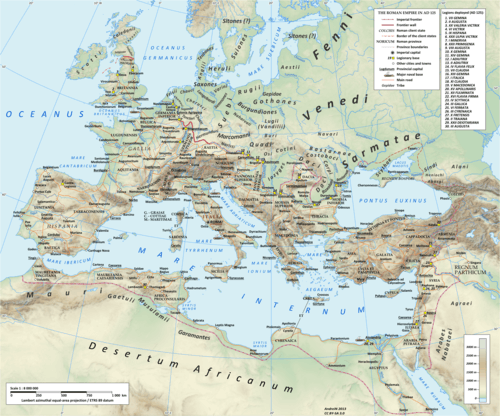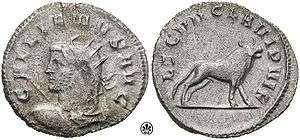Legio VII Claudia
Legio septima Claudia (Claudius' Seventh Legion) was a legion of the Imperial Roman army.


History
They were ordered to Cisalpine Gaul around 58 BC by Julius Caesar, and marched with him throughout the entire Gallic Wars. The Roman commander mentions the Seventh in his account of the battle against the Nervians, and it seems that it was employed during the expedition through western Gaul led by Caesar's deputy Crassus[1]. In 56 BC, the Seventh was present during the Venetic campaign. During the crisis caused by Vercingetorix, it fought in the neighborhood of Lutetia; it must have been active at Alesia and it was certainly involved in the mopping-up operations among the Bellovaci.
Legio VII was one of the two legions used in Caesar's invasions of Britain, and played a crucial role in the Battle of Pharsalus in 48 BC, and it existed at least until the end of the 4th century, guarding the middle Danube.
Tiberius Claudius Maximus, the Roman soldier who brought the head of Decebalus to the emperor Trajan, was serving in Legio VII Claudia. An inscription in Pompeii revealed that a certain Floronius also served in the seventh legion. The inscription says: "Floronius, privileged soldier of the 7th legion, was here. The women did not know of his presence. Only six women came to know, too few for such a stallion."
Attested members
| Name | Rank | Time frame | Province | Source |
|---|---|---|---|---|
| Tettius Julianus | legatus | 68-69 | Tacitus, Histories, I.79 | |
| Plotius Grypus | legatus | 69-70 | Tacitus, Histories, III.52; IV.39, 40 | |
| Veturius Paccianus[2] | legatus | c. 168 | ||
| Gaius Memmius Fidus Julius Albius[3] | legatus | c. 180/182 | CIL VIII, 12442 = ILS 1110 | |
| Gaius Caesonius Macer Rufinianus[3] | legatus | c. 187/190 | CIL XIV, 390 = ILS 1182 | |
| Marcus Laelius Maximus[4] | legatus | 195 | CIL III, 8103 | |
| Publius Palpellius Clodius Quirinalis | military tribune | c. 50 | CIL V, 533 | |
| Lucius Vipstanus Messalla | military tribune | 69 | Tacitus, Histories, III.9 | |
| Galeo Tettienus Severus Marcus Eppuleius Proculus Tiberius Caepio Hispo | military tribune | between 85 and 90 | CIL V, 5813 | |
| Lucius Valerius Proculus | military tribune | 1st half 2nd century | CIL II, 1970 | |
| Gaius Valerius Florinum | military tribune | 1st half 2nd century | CIL XIV, 2957 | |
| Gaius Vettius Gratus Sabinianus[5] | military tribune | c.205 | ||
| Tiberius Claudius Maximus | vexillarius | between 85 and 90 | AE 1985, 721 |
See also
References
- Caesar, Bellum Gallicum 2.23
- Géza Alföldy, Konsulat und Senatorenstand unter der Antoninen (Bonn: Rudolf Habelt Verlag, 1977), p. 300
- Paul M. M. Leunissen, Konsuln und Konsulare in der Zeit von Commodus bis Severus Alexander (Amsterdam: J.C. Gieben, 1989), p. 340
- Leunissen, Konsuln und Konsulare, p. 341
- Inge Mennen, Power and Status in the Roman Empire, AD 193-284 (2011) p. 127
External links
Further reading
- D. Toncinić, Monuments of Legio VII in the Roman Province of Dalmatia. Split, 2011.
